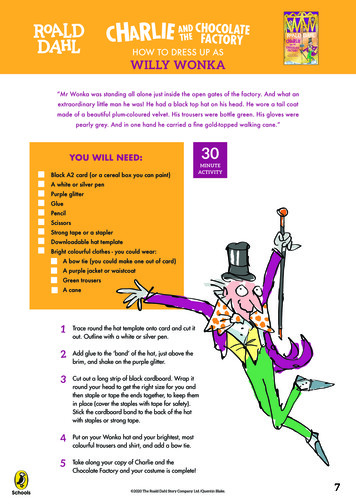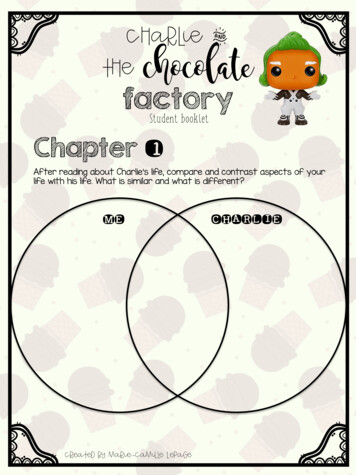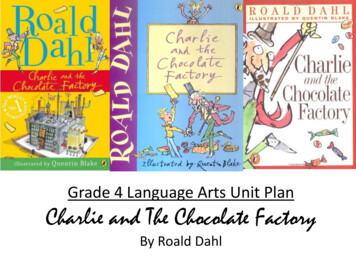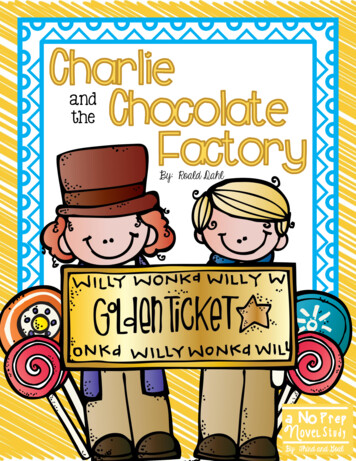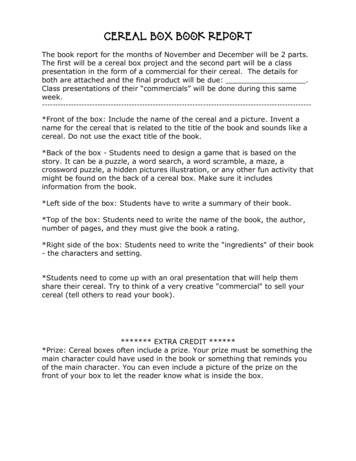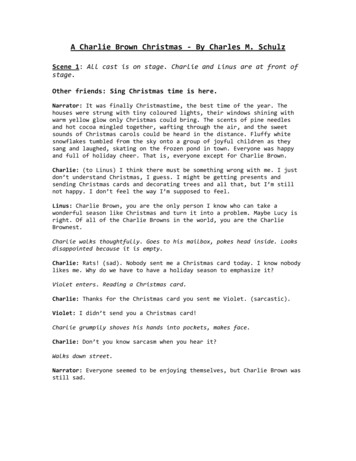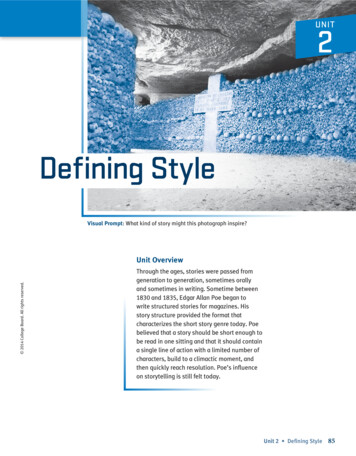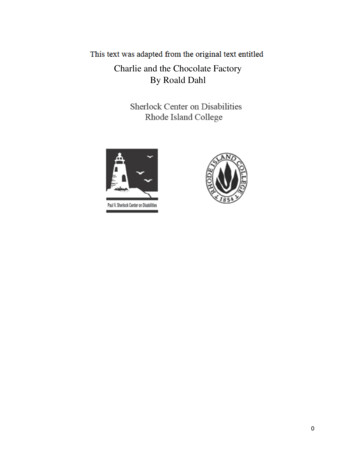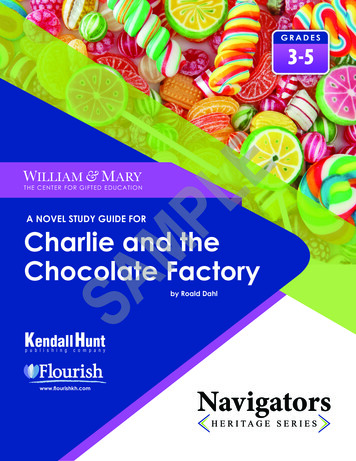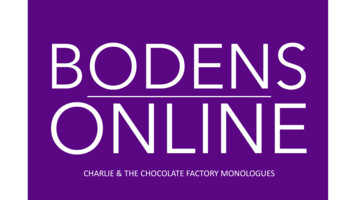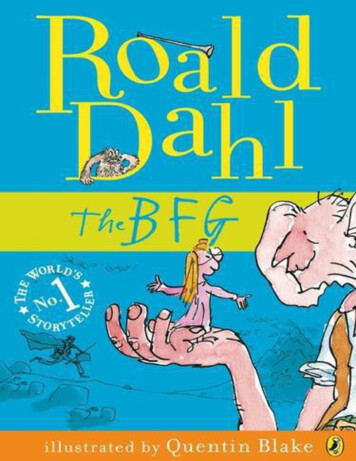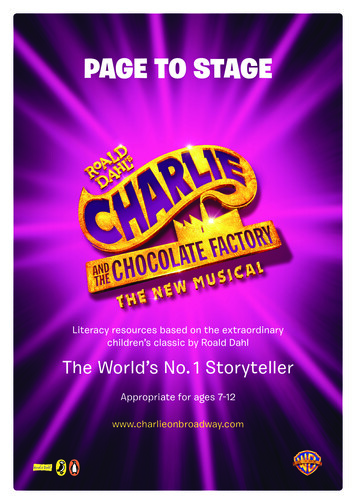
Transcription
Page to StageLiteracy resources based on the extraordinarychildren’s classic by Roald DahlThe World’s No. 1 StorytellerAppropriate for ages 7-12www.charlieonbroadway.com
Welcome to the wondrous worldof the major new stage musicalCharlie and the Chocolate Factory, the deliciously dark children’s classic, is being turned intoa brand-new Broadway musical from three-time Tony Award winning director Jack O’Brienand the Grammy and Tony-winning songwriters of Hairspray, Marc Shaiman and Scott Wittman.This study guide has been designed to help you explore the journey of this classic book frompage to stage with your students. It vividly captures the imagination and provides a greatopportunity for teachers to ignite students’ passion for reading and develop their literacy skills.Using Charlie and the Chocolate Factory as a focus, this resource pack contains engagingactivities that can be used by Elementary and Middle School teachers, or even keen fans ofRoald Dahl who want to take part at home.Your toolkit contains.An activity booklet that provides all the activity ideasActivity sheets containing activity instructions, templates and useful passagesfrom the book2
Throughout this study guide, you will find activities that connect the Broadway production ofCharlie and the Chocolate Factory to the following National Standards for Theatre Education:Content Standard #1: Script writing by planning and recording improvisations based onpersonal experience and heritage, imagination, literature, and history.Achievement Standard:a) Students collaborate to select interrelated characters, environments, and situations forclassroom dramatizationsb) Students improvise dialogue to tell stories, and formalize improvisations by writing orrecording the dialogueContent Standard #2: Acting by assuming roles and interacting in improvisationsAchievement Standard:a) Students imagine and clearly describe characters, their relationships, and their environmentsb) Students use variations of locomotor and nonlocomotor movement and vocal pitch, tempo,and tone for different charactersc) Students assume roles that exhibit concentration and contribute to the action of classroomdramatizations based on personal experience and heritage, imagination, literature, and historyContent Standard #3: Designing by visualizing and arranging environments for classroomdramatizationsAchievement Standard:a) Students visualize environments and construct designs to communicate locale and moodusing visual elements (such as space, color, line, shape, texture) and aural aspects using avariety of sound sourcesb) Students collaborate to establish playing spaces for classroom dramatizations and toselect and safely organize available materials that suggest scenery, properties, lighting,sound, costumes, and makeupContent Standard #4: Directing by planning classroom dramatizationsAchievement Standard:a) Students collaboratively plan and prepare improvisations and demonstrate various ways ofstaging classroom dramatizationsContent Standard #5: Researching by finding information to support classroom dramatizationsAchievement Standard:a) Students communicate information to peers about people, events, time, and place relatedto classroom dramatizations3
Content Standard #6: Comparing and connecting art forms by describing theatre, dramaticmedia (such as film, television, and electronic media), and other art formsAchievement Standard:a) Students describe visual, aural, oral, and kinetic elements in theatre, dramatic media, dance,music, and visual artsb) Students compare how ideas and emotions are expressed in theatre, dramatic media, dance,music, and visual artsc) Students select movement, music, or visual elements to enhance the mood of a classroomdramatizationContent Standard #7: Analyzing and explaining personal preferences and constructingmeanings from classroom dramatizations and from theatre, film, and electronic mediaproductionsAchievement Standard:a) Students identify and describe the visual, aural, oral, and kinetic elements of classroomdramatizations and dramatic performancesb) Students explain how the wants and needs of characters are similar to and different fromtheir ownc) Students article emotional responses to and explain personal preferences about the wholeas well as the parts of dramatic performancesd) Students analyze classroom dramatizations and, using appropriate terminology,constructively suggest alternative ideas for dramatizing roles, arranging environments,and developing situations along with means of improving the collaborative processes ofplanning, playing, responding, and evaluatingContent Standard #8: Understanding context by recognizing the role of theatre, film,television, and electronic media in daily lifeAchievement Standard:a) Students identify and compare similar characters and situations in stories and dramasfrom and about various cultures, illustrate with classroom dramatizations, and discuss howtheatre reflects lifeb) Students identify and compare the various settings and reasons for creating dramas andattending theatre, film, television, and electronic media productionsThe National Standards for Theatre Education were developed by the American Alliance for Theatre and Educationin cooperation with the Educational Theatre Association and as part of the National Standards for Arts Education,a product of the Consortium of National Arts Education Associations.4
Activity ideasActivity ideas are focused into two themes: Crazy Characters and Mr Wonka’s Fantastic Factory.Delivery notes and resources are included to make it fun and interactive support for all. Activitiessupport the speaking, listening, reading and writing elements of the English curriculum. They caneither be slotted into your existing teaching or used to deliver a broader program of study onCharlie and the Chocolate Factory.Book your visit todaySchool tickets are available to order from the Charlie and the Chocolate Factory website atcharlieonbroadway.com. The resources in this pack can be used in the build-up to seeing theshow or after your trip to further develop students’ learning and understanding.5
Crazy CharactersActivity: Slam writingResourcesWorksheet 1 (on page 7)Learning objectivesStudents should Be able to describe the characters using appropriate vocabulary. Explain that all of the characters in Charlie and the Chocolate Factory have different looksand personalities. Give students 30 seconds to write down all of the words they can think of to describe eachof the following characters: Willy Wonka Charlie Bucket Grandpa Joe Augustus Gloop The Oompa-Loompas Violet Beauregarde Once students have completed each list, ask them for the words they wrote down andcollect them on the board. Worksheet 1 contains profiles of each of the characters. Did the class write down manyof the words included in each character’s profile?Activity: Diary entryResourcesWorksheet 1 (on page 7)Learning objectivesStudents should Be able to write from a character’s perspective.Understand how a character is portrayed in a piece of drama. Ask students to choose one of the characters profiled on Worksheet 1 or assign each studenta character and ask them to read the relevant character profile. Students will write an imaginary diary entry for the night before Willy Wonka’s factory opensfor the tour. They should think about the way their character thinks and consider how they might befeeling. Are they excited, and if so, why? What are they looking forward to? Have they gotany worries about the trip? Higher-ability students should think about the tone of voice theyuse for their diary entry-does it match the sort of language their character uses in the book? Once students have completed their entry they can swap it with another student who readsit to the rest of the class. Ask students to imagine they will be playing their character in the new musical and thinkabout how they could transform their piece of writing into a performance.How do they imagine the character’s voice to sound?Would they talk quickly or slowly?Would they use a lot of gestures?They can perform their entry at the end of the lesson.6
Crazy Characters – Worksheet 1Willy WonkaCharlie BucketWilly Wonka is the best chocolate maker andinventor in the world. He owns a big factorywhere he creates delicious candies andchocolates.Charlie comes from a poor family and lives ina wooden house with his parents andgrandparents.He is a small man who dresses in a top hatand brightly colored clothes.He is an unusual man who does not trustother people since spies started giving awayhis secret recipes.He is willing to try anything and refuses tobelieve other people who say things areimpossible.Grandpa JoeGrandpa Joe is 96 years old. He hasn’t beenout of bed for 20 years when Charlie finds aGolden Ticket, but when he hears the news hejumps out of bed to celebrate and accompanyCharlie on the tour.He is very tall and thin.Grandpa Joe is a great storyteller but can geta bit overexcited. He loves chocolate as well.Charlie is a very small boy with ragged clothesbecause he is so poor he can’t afford to eatvery much or buy new clothes.He loves chocolate but only gets onechocolate bar per year for his birthday.He is very close to his grandparents andenjoys listening to their stories.Charlie is very selfless and is always thinkingof others.Augustus GloopAugustus Gloop finds the first Golden Ticket.He is a very greedy young man who has onlyone habit – eating. As a result he is very fat,but his mother doesn’t seem to worry abouthis health.Augustus is so overexcited about the river ofchocolate in Wonka’s factory that he startsdrinking from it and falls in.Grandpa Joe is a big fan of Willy Wonka andis overjoyed that he gets to visit the factory.The Oompa-LoompasOompa-Loompas are small people with longhair who come from a tropical country calledLoompaland. In their homeland they had spenttheir whole lives in the trees, hiding from theterrible creatures on the ground.Their favorite food is cacao beans and theyagreed to come and work in Mr Wonka’sfactory in exchange for as many cacao beansas they could eat.They are very mischievous and like to singsongs all day to entertain themselves.Violet BeauregardeViolet Beauregarde finds the third GoldenTicket.She loves chewing gum more than anythingbut switches to chocolate to help find theticket.Violet’s current record for chewing the samepiece of gum is three months. After everynight she sticks it on the bedpost and thenstarts again in the morning.She is very rude about her mother who shethinks nags her, and enjoys sticking her gumon the buttons in the elevator so people get itstuck on their fingers.7
Crazy CharactersActivity: Character cardsResourcesWorksheet 2 (on page 9)Learning objectivesStudents should Be able to research a character and identify key traits. One of the big jobs in transforming the book into a musical is working out how to bringthe characters to life on stage. Using the template on Worksheet 2, students should create a character card for one of thefollowing characters: Mr Bucket Veruca Salt Mike Teavee Some suggestions of key passages, which students could use for reference, are provided foreach character on Worksheet 2. The completed character cards could be used to make a classroom display.ct!tic fary for everysatniaheFapt a dting teicDahl kfe.r, depRoald of the yea s and wildlihmont ing seasonchang8
Crazy Characters – Worksheet 2Character Name:Draw a picture of the characterWhat does this character like to do?What are this character’s good points?What are this character’s bad points?What happens to this character at the end of the book?9
Crazy CharactersActivity: Spotting adjectivesResourcesWorksheet 3 (on page 11)Learning objectivesStudents should Know what an adjective is used for.Be able to identify adjectives in a piece of writing. Students should read the extracts on Worksheet 3 and use a colored pen to highlightthe adjectives. Create a list of the adjectives used by Roald Dahl to describe Willy Wonka andAugustus Gloop. As a class discuss the different words that are used for each – how do they help to builda picture of the characters? Can students use a thesaurus to find any other words thatRoald Dahl could have used to describe them? Choose one of the words students have chosen and conduct a word association exercise.Discuss the fact that each word has many different connotations and is important in howthe reader perceives a character. Discuss how these describing words would help the people developing the new musicalto imagine the characters.10
Crazy Characters – Worksheet 3Spotting the adjectivesAdjectives are describing words. They are used to describe nouns (things, people or places).Adjectives normally come before or after the noun.Read the two passages below and underline all of the adjectives that you find to describethe two characters.Willy WonkaChapter 14Mr Wonka was standing all alone just inside the open gates of the factory. And what anextraordinary little man he was! He had a black top hat on his head. He wore a tailcoatmade of a beautiful plum-colored velvet. His trousers were bottle green. His gloves werepearly grey. And in one hand he carried a fine gold-topped walking cane.Covering his chin, there was a small, neat, pointed black beard — a goatee. And his eyes —his eyes were most marvelously bright. They seemed to be sparkling and twinkling at youall the time. The whole face, in fact, was alight with fun and laughter.And oh, how clever he looked! How quick and sharp and full of life! He kept making quickjerky little movements with his head, cocking it this way and that, and taking everything inwith those bright twinkling eyes. He was like a squirrel in the quickness of his movements,like a quick clever old squirrel from the park.Suddenly, he did a funny little skipping dance in the snow, and he spread his arms wide,and he smiled at the five children who were clustered near the gates, and he called out,‘Welcome, my little friends! Welcome to the factory!’His voice was high and flutey. ‘Will you come forward one at a time, please,’ he called out,‘and bring your parents. Then show me your Golden Ticket and give me your name.Who’s first?’( Roald Dahl Nominee Limited)Augustus GloopChapter 6The very next day, the first Golden Ticket was found. The finder was a boy called AugustusGloop, and Mr Bucket’s evening newspaper carried a large picture of him on the front page.The picture showed a nine-year-old boy who was so enormously fat he looked as though hehad been blown up with a powerful pump. Great flabby folds of fat bulged out from every partof his body, and his face was like a monstrous ball of dough with two small greedy currantyeyes peering out upon the world. The town in which Augustus Gloop lived, the newspapersaid, had gone wild with excitement over their hero. Flags were flying from all the windows,children had been given a holiday from school, and a parade was being organized in honor ofthe famous youth.‘I just knew Augustus would find a Golden Ticket,’ his mother had told the newspapermen.‘He eats so many bars of chocolate a day that it was almost impossible for him not to find one.Eating is his hobby, you know. That’s all he’s interested in. But still, that’s better than being ahooligan and shooting off zip guns and things like that in his spare time, isn’t it? And what Ialways say is, he wouldn’t go on eating like he does unless he needed nourishment, would he?It’s all vitamins, anyway. What a thrill it will be for him to visit Mr Wonka’s marvellousfactory! We’re just as proud as anything!’( Roald Dahl Nominee Limited)11
Mr Wonka’s fantastic factoryActivity: A ride in the glass elevatorResourcesWorksheet 4 (on page 13)Learning objectivesStudents should Be able to think imaginatively about situations in a story.Know how to plan and develop a piece of creative writing. Ask a class to read the extract on Worksheet 4.Now split the class into pairs and ask them to imagine that they are going to be ridingin the glass elevator. Ask each pair to invent a room that they would like to visit with the glass elevator.They should decide what the name of the room would be and what they will see whenthey arrive there. Once students have spent ten minutes deciding on this they should act out what theyfind when the glass elevator arrives in their room.What does the room look like, what do they find in the room?What happens when they explore the room?You may need to clear some space for this activity. Alternatively students could be asked to draw a storyboard of their adventure.After students have had time to explore their rooms they should write down key wordsabout what they found and what happened to them. Finally they should write a story about their visit, which can be used for a new scenein the musical. They should use the first sentence provided on the worksheet as astarting point.ct!tic fawrote insatnryysFal alwad a veuseDahlRoald d only ever llow pencienya.flpenci ular kind o on the endpartic an eraserwith12
Mr Wonka’s fantastic factory – Worksheet 4A ride in the glass elevatorChapter 25“Now then,” cried Mr. Wonka, “which button shall we press first? Take your pick!”Charlie stared around him in astonishment. This was the craziest elevator he had ever seen.There were buttons everywhere! The walls, and even the ceiling, were covered all over withrows and rows and rows of small, black push buttons! There must have been a thousand ofthem on each wall, and another thousand on the ceiling! And now Charlie noticed that everysingle button had a tiny printed label beside it telling you which room you would be taken toif you pressed it.“This isn’t just an ordinary up-and-down elevator!” announced Mr. Wonka proudly. “Thiselevator can go sideways and longways and slantways and any other way you can think of!It can visit any single room in the whole factory, no matter where it is! You simply press thebutton and zing!. you’re off!”“Fantastic!” murmured Grandpa Joe. His eyes were shining with excitement as he stared atthe rows of buttons.“The whole elevator is made of thick, clear glass!” Mr. Wonka declared. “Walls, doors, ceiling,floor, everything is made of glass so that you can see out!”“But there’s nothing to see,” said Mike Teavee.“Choose a button!” said Mr. Wonka. “The two children may press one button each.So take your pick! Hurry up! In every room, something delicious and wonderful isbeing made.”Quickly, Charlie started reading some of the labels alongside the buttons.THE ROCK-CANDY MINE - 10,000 FEET DEEP, it said on one.COKERNUT-ICE SKATING RINKS, it said on another.Then STRAWBERRY-JUICE WATER PISTOLS.TOFFEE-APPLE TREES FOR PLANTING OUT IN YOUR GARDEN – ALL SIZES.EXPLODING SWEETS FOR YOUR ENEMIES.LUMINOUS LOLLIES FOR EATING IN BED AT NIGHT.MINT JUJUBES FOR THE BOY NEXT DOOR – THEY’LL GIVE HIM GREEN TEETHFOR A MONTH.CAVITY-FILLING CARAMELS – NO MORE DENTISTS.STICKJAW FOR TALKATIVE PARENTS.WRIGGLE-SWEETS THAT WRIGGLE DELIGHTFULLY IN YOUR TUMMY AFTERSWALLOWING.INVISIBLE CHOCOLATE BARS FOR EATING IN CLASS.SUGAR-COATED PENCILS FOR SUCKING.FIZZY LEMONADE SWIMMING POOLS.MAGIC HAND-FUDGE – WHEN YOU HOLD IT IN YOUR HAND, YOU TASTE IT INYOUR MOUTH.RAINBOW DROPS – SUCK THEM AND YOU CAN SPIT IN SIX DIFFERENT Colors.“Come on, come on!” cried Mr. Wonka. “We can’t wait all day!”( Roald Dahl Nominee Limited)13
Mr Wonka’s fantastic factory –Worksheet 4 (CONTINUED)Activity1. Imagine you are in the elevator with Charlie, Mr Wonka and Mike Teavee and you getto choose which button to press and which room to visit. You will be acting out whathappens when you push your chosen button. First think about the questions belowand write notes about what you imagine. What would the name of the room be on the button?What would the journey to your room be like?What do you find in the room?What happens when you explore the room?Do you meet anyone new in the room?What happens to the other characters in the room? Write down what you see, hear, smell and touch in your room.2. Now act out your trip to the room. Try to imagine all the things that you see and howyou react when you reach your room. You can act it out a few times and make somechanges each time. This will help you to paint a detailed picture of your room andwhat happens there in your head.3. Now you have decided what the room is like and imagined what happens when youvisit it, write a short story about the way in which it could be used as the basis fora new scene in the Charlie and the Chocolate Factory musical. Use this as your firstsentence:Suddenly I saw it. There was no question about it; this was the button which I wantedto press. I was so excited I was shaking! Slowly I reached down towards the floorand pressed the button. It gave a satisfying click but at first nothing happened.Then, all of a sudden.14
Mr Wonka’s fantastic factoryActivity: Storyboarding the sceneResourcesNone requiredLearning objectivesStudents should Know how a piece of writing is transformed into drama.Be able to create simple storyboards. Explain that Charlie and the Chocolate Factory is being turned into a brand-newmusical stage production. One way to help visualize how a story will be transformedfrom a book into a play is to create a storyboard of the scenes. Students pick a short passage from the book and create a storyboard to show how thatpassage could look in the stage show. Their storyboard should be made up of five frames. They should consider where the characters are standing, how they move about thestage and what props they might need. Explain that students don’t need to createamazing drawings, but they need to show how the characters move around the stage.They can include notes underneath each frame to explain them.Activity: Design an adResourcesCollect some magazine adsLearning objectivesStudents should Understand how to write persuasively.Be able to use pictures and words to create a persuasive piece. In the Television Chocolate Room, Willy Wonka invents an incredible machine to help createamazing ads for his chocolate bars. Ask students to create an ad for one of the following candies from Willy Wonka’sChocolate Factory: Lickable wallpaper The everlasting gobstopper Hair toffee Luminous lollies for bedtimes Hot ice creams for cold days Once they have chosen their product, students should think about to whom they are goingto be marketing their product and also what its selling points are. The ad should be designed to take up one page in a magazine. Collect some examplesand use them to help guide students on how to create their ad. Remind students that their ad should be very persuasive and get across all the importantinformation very quickly. The ad should also be visually appealing so ask students toinclude pictures they have drawn or cut out. Students can use the information in the book to find out about the candy or they can usetheir imagination to decide what the candy will be like. Explain that students could use the following techniques in their ad: bold writing; colorfulpictures; the rule of three; rhyme; alliteration; catchy words.15
Mr Wonka’s fantastic factoryActivity: Setting the sceneResourcesNone requiredLearning objectivesStudents should Be able to retain information from written passages and use their imagination to developit further. As a class, read the beginning of chapter 15 which describes the Chocolate Room inWilly Wonka’s factory. Once you have read the description ask all students to shut their books. Students shouldimagine they are working on the sets for the new Charlie and the Chocolate Factory musicaland draw the Chocolate Room from memory. They should try and include as many details asthey can remember from the passage. Once students have spent 10 minutes on their drawings read through the passage again.How much did students remember? Were there any features they missed?Activity: Unchartered territoryResourcesNone requiredLearning objectivesStudents should Know some of the different types of maps and their uses.Be able to scan text for information. Students use their imaginations to create a map of the Chocolate Factory.Use the book to introduce different types of maps and remind students of some of therooms which are mentioned in the story. Remind students that they don’t have to strictly try and reflect the factory described in thebook, they can use their imagination to create the factory they would like to visit!16
Mr Wonka’s fantastic factoryActivity: The final chapterResourcesWorksheet 5 & 6 (on pages 18 and 19)Learning objectivesStudents should Be able to plan and note initial ideas.Know how to develop and improve a story.Be able to write imaginatively.Part 1 In the final chapter of Charlie and the Chocolate Factory, Willy Wonka collects Charlie’sfamily in the glass elevator in order to take them back to live in and run his factory. Split students into groups and give each group one of the adventure cards (these can beprinted and cut out from Worksheet 5). Students should look at the scenario and discuss as a group how the characters will solveeach problem. Discuss their ideas as a class. Explain that they will now be writing an extra part for the new stage musical versionCharlie and the Chocolate Factory using the ideas they developed from the adventure card.Part 2 Place students in a pair with someone from a different group. They will be using aninterview-style exercise to help develop their ideas further and view the story from thecharacter’s perspective. One student will take on the role of their character while the otherasks them questions. This activity could be carried out two or three times with students swapping partners eachtime; this will help students to develop and improve their writing even further.Part 3 Now students will plan their piece of writing by completing Worksheet 6.Students will identify the characters involved, describe the setting, outline the problem andthen explain the resolution. Remind students to use exciting language in their writing and tomake sure they explain not just what is happening but how their characters feel about it.ct!tic fa eas book,satnidFaept anall hisdownDahl kdRoald e he wrote ought goohrte,heswHdreamdeas.best i s were like ten.idea on forgotso17
Mr Wonka’s fantastic factory – Worksheet 5Adventure cardsAdventure card 1While flying from the Bucket’s houseto the chocolate factory, GrandmaJosephine grabs the controls and theelevator flies into space. How will yousurvive and get back to earth?Adventure card 3When you arrive at the chocolate factoryyou find that a vicious Whangdoodle hashidden in one of the crates deliveredfrom Loompaland and is rampagingaround the chocolate room.How will you capture the beast?Adventure card 5You return to the factory and beginexploring the different rooms. You finda genie in an old crate of cacao beanswho promises to give you one wish.What will your wish be?Adventure card 2You arrive back at the chocolate factoryto find that rain has come through thehole in the roof and flooded theOompa-Loompa’s homes.How will you rescue them?Adventure card 4Mr Wonka falls ill while the elevator isflying back to the factory and he divertsthe flight to Loompaland, the only placewhere a cure can be found. Where will youfind the cure for Mr Wonka?Adventure card 6Once you return to the factory Mr Wonkadecides that he wants to celebrateCharlie’s ownership of the factory byreleasing a new candy. What will the newcandy be and how will it be made?18
Mr Wonka’s fantastic factory – Worksheet 6Use the headings below to help structure your chapter:Characters:What characters will be involved in your chapter?Setting:Where does the chapter take place?Do the characters go to more than one place?Problem:What is the problem that the characters have to solve?Resolution:How do they solve the problem and what happens once it has been solved?19
ACTIVITY: WHO’S INVOLVED?ResourcesWorksheet 7 (on page 21)Video interviews Explain to students that Charlie and the Chocolate Factory is being transformed intoa brand-new Broadway musical. Discuss what a musical is and explore what students would expect to see in a theatre.Conduct a brainstorm around the different jobs that students think are involved in developinga musical; distribute copies of Worksheet 7 to introduce some of the jobs. Were there any jobs that students didn’t expect to see? Which jobs do they think they wouldenjoy most and why?ACTIVITY: DESIGN A SET PART 1 Explain to students that set design is very important for a musical as it lets the audienceknow where the characters are and helps to set the tone for the scene. Show students a set design model for Charlie and the Chocolate Factory.Ask students to write down five words that describe the set model shown in the image.Ask students to volunteer some of the words they have written down; what does the set tellthem about the Bucket family’s life?ACTIVITY: DESIGN A SET PART 2ResourcesWorksheet 8 (on page 22) Split students into small groups and explain that they will be designing a set for one of therooms in the book. You could ask them to choose their own or assign one of the following: The Inventing Room (Chapter 19) The Chocolate Room (Chapter 15) The Television Chocolate Room (Chapter 26) The Bucket family’s home (Chapter 1) Show the video that demonstrates the design team’s development process for a scene.Ask students to make a list of all the items they think should be shown in the set;they may need to re-read parts of the book to help focus on that setting again. Once they have formed a list of items they should create a “mood board” to showthe tone of the set; they should cut out inspiring images from magazines or print out fromthe Internet.Worksheet 8 will provide some ideas on how to create a “mood board”.20
WHO’S INVOLVED? – WORKSHEET 7DirectorComposerLyricistBook Writ
2 Charlie and the Chocolate Factory, the deliciously dark children’s classic, is being turned into a brand-new Broadway musical from three-time Tony Award winning director Jack O’Brien and the Grammy and Tony-winning songwriters of Hairspray, Marc Shaiman and Scott Wittman. This study guide has been designed to help you explo
